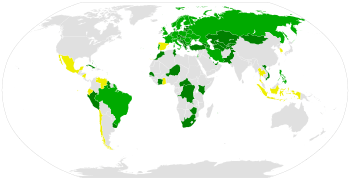Vienna Convention on Road Traffic
The Convention on Road Traffic, commonly known as the Vienna Convention on Road Traffic, is an international treaty designed to facilitate international road traffic and to increase road safety by establishing standard traffic rules among the contracting parties. The convention was agreed upon at the United Nations Economic and Social Council's Conference on Road Traffic (7 October – 8 November 1968) and concluded in Vienna on 8 November 1968. It came into force on 21 May 1977. This conference also produced the Convention on Road Signs and Signals. The Convention had amendments on 3 September 1993 and 28 March 2006. There is a European Agreement supplementing the Convention on Road Traffic (1968), which was concluded in Geneva, on 1 May 1971.
Contracting parties
The Vienna Convention on Road Traffic was concluded at Vienna on 8 November 1968. Since its entry into force on 21 May 1977, in signatory countries ("Contracting Parties") it replaces previous road traffic conventions, notably the 1949 Geneva Convention on Road Traffic, in accordance with Article 48 of the Convention. The convention has been ratified by 83 countries, but those who have not ratified the convention may still be parties to the 1949 Geneva Convention on Road Traffic. Ireland, Canada, the United States, Cyprus, Iceland, Malta, China and Malaysia are examples of non-signatory countries. Several other countries, such as Spain and Mexico, have signed the convention but have not ratified it.[2]
Short-term tourists are not permitted to bring cars into China. All foreign-registered vehicles in China must display a Chinese vehicle registration plate. In Malaysia, foreign registered vehicles are required to adhere to Malaysian window tint limit regulations or will be denied entry into Malaysia.[3]
Cross-border vehicles
One of the main benefits of the convention for motorists is the obligation on signatory countries to recognize the legality of vehicles from other signatory countries. The following requirements must be met when driving outside the country of registration:
- Cars must display their registration number at the front and rear, even if legislation in the jurisdiction of registration does not require a front vehicle registration plate on cars. Motorcycles need to display their registration number only at the rear. Registration numbers must be composed either of numerals or of numerals and letters. They must be displayed in capital Latin characters and Arabic numerals. In addition to this, the registration number may optionally be displayed in a different alphabet.
- A distinguishing sign of the country of registration must be displayed on the rear of the vehicle. This sign may either be placed separately from the registration plate or may be incorporated into the vehicle registration plate. When the distinguishing sign is incorporated into the registration plate, it must also appear on the front registration plate of the vehicle if such is obligatory. [4]
- The physical requirements for the separate sign are defined in Annex 3 of the Vienna Convention on Road Traffic, which states that the letters shall be in black on a white background having the shape of an ellipse with the major axis horizontal. The distinguishing sign should not be affixed in such a way that it could be confused with the registration number or impair its legibility. When the distinguishing sign is incorporated into the registration plate, it must also appear on the front registration plate of the vehicle, and may be supplemented with the flag or emblem of the national state, or the emblem of the regional economic integration organization to which the country belongs. The distinguishing sign should be displayed on the far left or far right on the registration plate. When a symbol/flag/emblem is also displayed, the distinguishing sign shall obligatory be placed on the far left on the plate. The distinguishing sign shall be positioned so to be easy identifiable and so that it cannot be confused with the registration number or impair its legibility. The distinguishing sign shall therefore be at least a different color from the registration number, or have a different background color to that reserved for the registration number, or be clearly separated from the registration number, preferably with a line.[5]
- In practice, the requirement to display a distinguishing sign, as defined in the Vienna Convention on Road Traffic, is mutually waived between some countries, for example within the European Economic Area, for vehicles with license plates in the common EU format (which satisfies the requirements of the Vienna Convention on Road Traffic, and hence are also valid in non-EU countries signatory to the convention) issued in EU member states,[6] and between Canada, the United States, and Mexico (where the province, state, or district of registration is usually embossed or surface-printed on the vehicle registration plate).
- The vehicle must meet all technical requirements to be legal for road use in the country of registration. Any conflicting technical requirements (e.g., right-hand-drive or left-hand-drive) in the signatory country where the vehicle is being driven do not apply.
- The driver must carry the vehicle's registration certificate, and if the vehicle is not registered in the name of an occupant of the vehicle (e.g., a hire car), proof of the driver's right to be in possession of the vehicle.
The convention also addresses minimum mechanical and safety equipment needed to be on board and defines an identification mark (Annex 4) to identify the origin of the vehicle.
Vienna Convention and autonomous driving
One of the fundamental principles of the Convention has been the concept that a driver is always fully in control and responsible for the behavior of a vehicle in traffic.[7] This requirement is challenged by the development of technology for collision avoidance systems and autonomous driving.
International Driving Permit
The Vienna Convention on Road Traffic is the newest of three conventions that governs International Driving Permits. The other two are the 1926 Paris International Convention relative to Motor Traffic and the 1949 Geneva Convention on Road Traffic. When a state is contracting to more than one convention, the newest one terminate and replace previous ones in relation between those states.
The main regulations about driving licences are in Annex 6 (domestic driving permit) and Annex 7 (International Driving Permit). The currently active version of those is in force in each contracting party since no later than 29 March 2011 (Article 43). According to the 1968 Vienna Convention, an IDP must have an expiration date of no more than three years from its issue date or until the expiration date of national driving permit, whichever is earlier, and it is valid for a period of one year upon the arrival in the foreign country.
Article 41 of the convention describes requirements for driving licences. Key of those are:
- every driver of a motor vehicle must hold a driving licence;
- driving licences can be issued only after passing theoretical and practical exams, which are regulated by each country or jurisdiction;
- Contracting parties shall recognize as valid for driving in their territories:
- any domestic driving licence drawn up in their national language or in one of their national languages, or, if not drawn up in such a language, accompanied by a certified translation;
- domestic driving licence conforms to the provisions of annex 6 to the convention;
- International Driving Permit conforms to the provisions of annex 7 to the convention, on condition that it is presented with the corresponding domestic driving licence;
- driving licences issued by a contracting party shall be recognised in the territory of another contracting party until this territory becomes the place of normal residence of their holder;
- all of the above does not apply to learner-driver licences;
- the period of validity of an international driving permit shall be either no more than three years after the date of issue or until the date of expiry of the domestic driving licence, whichever is earlier;
- Contracting parties may refuse to recognise the validity of driving licences for persons under eighteen or, for categories C, D, CE and DE, under twenty-one;
- an international driving permit shall only be issued by the contracting party in whose territory the holder has their normal residence and that issued the domestic driving licence or that recognised the driving licence issued by another contracting party; it shall not be valid for use in that territory.
| Category | Description | Category | Description |
|---|---|---|---|
| Motorcycles | Motorcycles with a cubic capacity not exceeding 125 cm³ and a power not exceeding 11 kW (light motorcycles) | ||
| Motor vehicles, other than those in category A, having a permissible maximum mass not exceeding 3,500 kg and not more than eight seats in addition to the driver's seat; or motor vehicles of category В coupled to a trailer the permissible maximum mass of which does not exceed 750 kg; or motor vehicles of category В coupled to a trailer the permissible maximum mass of which exceeds 750 kg but does not exceed the unladen mass of the motor vehicle, where the combined permissible maximum mass of the vehicles so coupled does not exceed 3,500 kg | Motor tricycles and quadricycles | ||
| Motor vehicles, other than those in category D, having a permissible maximum mass exceeding 3,500 kg; or motor vehicles of category С coupled to a trailer the permissible maximum mass of which does not exceed 750 kg | Motor vehicles, with the exception of those in category D, the permissible maximum mass of which exceeds 3,500 kg but does not exceed 7,500 kg; or motor vehicles of subcategory C1 coupled to a trailer, the permissible maximum mass of which does not exceed 750 kg | ||
| Motor vehicles used for the carriage of passengers and having more than eight seats in addition to the driver's seat; or motor vehicles of category D coupled to a trailer the permissible maximum mass of which does not exceed 750 kg | Motor vehicles used for the carriage of passengers and having more than 8 seats in addition to the driver's seat but not more than 16 seats in addition to the driver's seat; or motor vehicles of subcategory D1 coupled to a trailer, the permissible maximum mass of which does not exceed 750 kg | ||
| Motor vehicles of category В coupled to a trailer the permissible maximum mass of which exceeds 750 kg and exceeds the unladen mass of the motor vehicle; or motor vehicles of category В coupled to a trailer the permissible maximum mass of which exceeds 750 kg, where the combined permissible maximum mass of the vehicles so coupled exceeds 3,500 kg | |||
| Motor vehicles of category С coupled to a trailer whose permissible maximum mass exceeds 750 kg | Motor vehicles of subcategory C1 coupled to a trailer the permissible maximum mass of which exceeds 750 kg but does not exceed the unladen mass of the motor vehicle, where the combined permissible maximum mass of the vehicles so coupled does not exceed 12,000 kg | ||
| Motor vehicles of category D coupled to a trailer whose permissible maximum mass exceeds 750 kg | Motor vehicles of subcategory D1 coupled to a trailer, not used for the carriage of persons, the permissible maximum mass of which exceeds 750 kg but does not exceed the unladen mass of the motor vehicle, where the combined permissible maximum mass of the vehicles so coupled does not exceed 12,000 kg |
Prior to 29 March 2011, annex 6 and annex 7 defined forms of driver's licences that are different from those defined after that date. Driving licences issued before 29 March 2011 that match older edition of the annexes are valid until their expiration dates (article 43).
Before 29 March 2011 the convention demanded contracting parties to recognise as valid for driving in their territories:
- any domestic driver's licence drawn up in their national language or in one of their national languages, or, if not drawn up in such a language, accompanied by a certified translation;
- any domestic driver's licence conforming to the provisions of annex 6 to the convention; and
- any international driver permit conforming to the provisions of annex 7 to the convention.
International conventions on transit transport
The broad objective of these international conventions and agreements, the depositary of which is the Secretary-General of the United Nations, is to facilitate international transport while providing for a high level of safety, security, and environmental protection in transport:
- Agreement on the International Carriage of Perishable Foodstuffs and on the Special Equipment to be used for such Carriage (ATP) (1970)
- Convention on Customs Treatment of Pool Containers Used in International Transport (1994)
- Convention on the Contract for the International Carriage of Goods By Road (1956) and its protocol (1978)
- Convention concerning Customs Facilities for Touring (1954)
- Customs Convention on Containers (1956, 1972)
- Customs Convention on the Temporary Importation of Commercial Road Vehicles (1956)
- Customs Convention on the Temporary Importation of Private Road Vehicles (1954)
- European Agreement concerning the International Carriage of Dangerous Goods by Road (ADR) (1957) and its Protocol amending articles 1 and 14 (1993)
- Geneva Convention on Road Traffic (1949)
- European Agreement concerning the Work of Crews of Vehicles engaged in International Road Transport (1970)
- International Convention to Facilitate the Crossing of Frontiers for Passengers and Baggage Carried by Rail (1952)
- International Convention to Facilitate the Crossing of Frontiers for Goods Carried by Rail (1952)
- International Convention on the Harmonization of Frontier Controls of Goods (1982)
- TIR Convention
See also
- Vienna Convention on Road Signs and Signals
- List of international vehicle registration codes
- International Driving Permit
- Rules of the road
References
- "Status of 19. Convention on Road Traffic". United Nations. Retrieved 2020-05-23.
- "UNTC". 2020-08-14.
- "Foreign cars with dark window tints barred from Malaysia". 2017-12-19.
- Artcile 37 - Distinguishing sign of the State of registration | Vienna Convention on Road Traffic (Consolidated version)
- "Annexes- Distinguishing Sign of Motor Vehicles and Trailers to International Traffic- Convention on Road Traffic on 8 November 1968".
- "Council Regulation (EC) No 2411/98". Council of the European Union. 3 November 1998.
- Global Automotive Regulation page related to automated driving
- "1968 Convention on Road Traffic (2006 consolidated version) in English, French, Spanish, Russian, Chinese and Arabic" (PDF). unece.org.
- International Driving Permit Categories - 1968 convention on road traffic (differences between International Driving Permit Categories in 1968 convention and EU driving licence directive 2006) , unece.org
External links
- Ratifications (list of countries)
- Vienna Convention on Road Traffic (Consolidated version).
- Distinguishing signs used on vehicles in international traffic (status as at 15 February 2007)
- Official text in several languages (version 1977)




